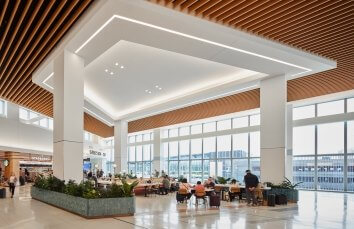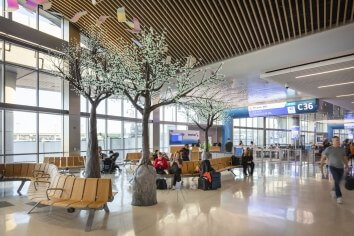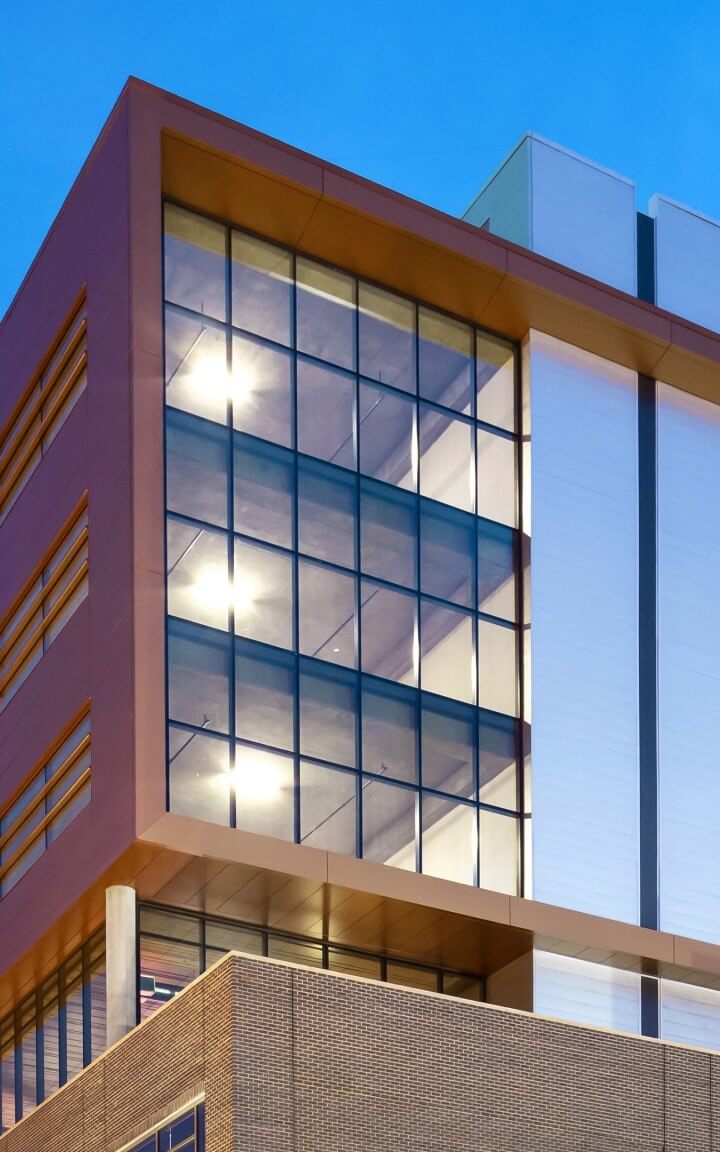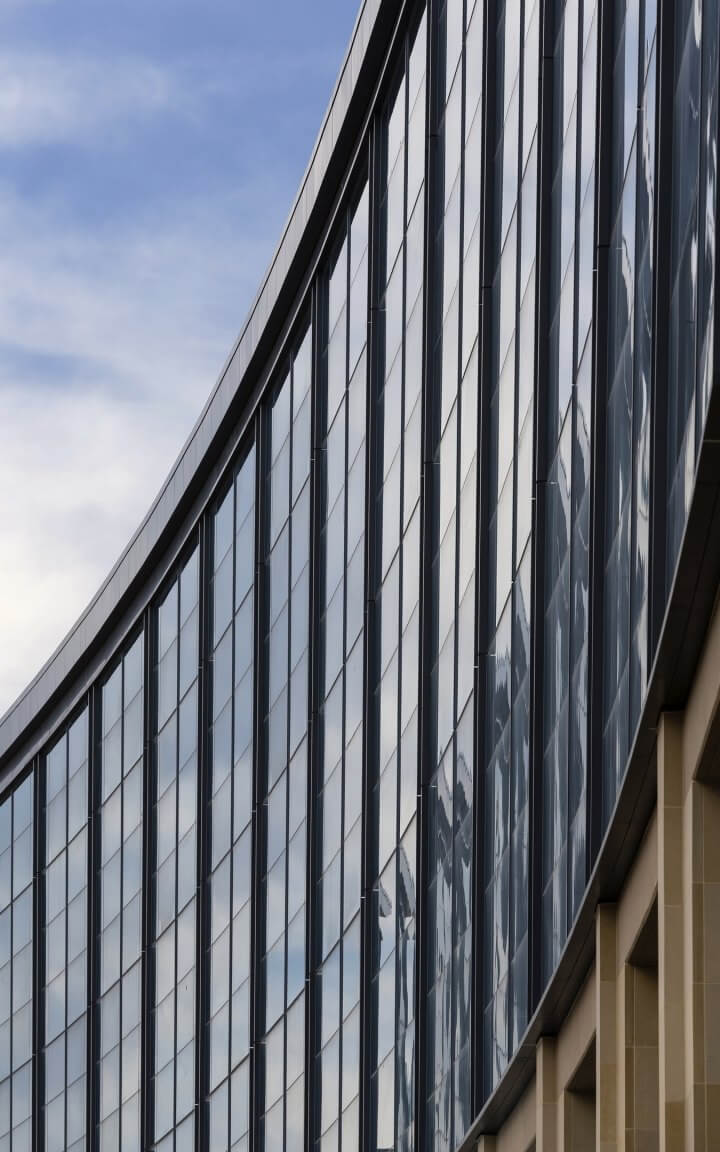It’s Not the Destination, It’s the Journey

In 2023, air traffic levels were back to 94% of pre-pandemic levels, with even stronger growth (more than 98%) in the fourth quarter. As the aviation industry recovers in terms of numbers, airlines and airports are adapting to this shift in passengers’ demands. It’s not just about the destination anymore, it’s about the travel experience from start to end.
Great Expectations
The expectations of travelers—already shifting prior to 2020—changed rapidly in the wake of the pandemic. Millennials and Gen Z are a growing cohort of travelers (and spenders), and they have different expectations and desires than previous generations: they travel more, they rely on social media reviews for planning, and yes, they really want their trip to be Instagram-able. Regular travelers of all generations got used to the efficiency of emptier terminals and enjoyed the convenience of touchless technology. As air traffic rebounds from the lows of the pandemic, airports and airlines are looking at ways to improve the passenger experience, increase their ratings, and ensure Millennials and Gen Zs are repeat customers.

Satisfaction with the airport terminal experience can be broken down into two categories: essential functions that must be smooth and painless and extras that can delight passengers but are not an expected part of the travel experience. Essential functions include:
- security (be fast)
- wayfinding (be clear)
- restrooms (be plentiful), and
- seating (be comfortable).
Luxuries that elevate the experience could include:
- a noticeable “wow” moment within the terminal
- enticing food and beverage options
- a connection to the outdoors, either physically or via views.
The incentive to get the customer experience correct isn’t just to garner brand loyalty — happy customers spend more money. A 2023 study from J.D. Power showed that customers who rated their experience as a 10 out of 10 spent 50% more than customers who rated their experiences as a five or under. So, designing for the passenger experience is a win-win: the traveler is happier and the airport is more profitable.
Function First
In general, airports are not seen as a place you want to go—it’s the place you have to go to get to where you want to go. But airports and airlines are eager to make updates that ensure passengers are happy, and garner top ratings.
To make sure that the passenger experience is smooth and stress-free, we pay a lot of attention to how passengers move through the terminal and what their touchpoints are. Clarity in the architecture, in materials and patterns, as well as the strategic use of lighting all naturally guide passengers along the paths they should take. At Dallas Love Field, for example, the effective use of volume, light and materials intuitively separates outbound and inbound passenger flows through a shared space without the need for signage. Likewise, the simple and elegant use of form, light and material at the expansion of Houston’s Hobby airport enabled that airport to achieve a Skytrax 5 Star rating for comfort and cleanliness.
Developing a customer journey map is another valuable tool in understanding the passenger experience. Corgan’s research group, Hugo, used this strategy in the Ontario International Airport Authority (ONT)’s Experiential Objectives Analysis (EOA). In that study, the team used secondary research as well as extensive interviews, on-site data collection, and other primary sources to develop a passenger journey map that identified gaps in service or amenities to inform their development plan.

The outcome of these large-scale improvement projects is tangible: the JD Power 2023 North America Airport Satisfaction Study showed airports that had recently undergone updates to improve basic functions like passenger flow had higher satisfaction rates than those that had not been updated. In short: designing for efficiency and experience is key for satisfaction and loyalty.
Thank You for Flying
As much as we focus on designing for function, we are also very focused on creating and promoting the local experience and a sense of place. In other words, terminals are ambassadors, representing their cities and previewing the experiences that await their visitors.
The airport could be their first impression of the city, therefore airport stakeholders are incentivized to make ita memorable one by designing terminals with the local culture embedded. This could be as involved as a signature moment relating to the structure, like the new Nashville International Airport (BNA)—with its guitar-inspired baffle ceilings fretted with repetitive skylights punctuated by a sound hole oculus—or as simple as the material and art curation, like the murals and sculptures comissioned to represent New York City’s art scene at La Guardia Terminal C in collaboration with the Queens Museum. Airport lounges have been incorporating the local brand for many years, and airports are now seeing the benefits of branding as well. When we can include a distinctive moment, it becomes a memory for the traveler, who then has a positive association with that place and develops an affinity for the place and experience.

More On BNA's Design Process
In addition to incorporating local culture, we look to enhance the passenger experience by offsetting some of the anxiety of travel through amenities and design elements that are calming. For example, having dynamic displays with real time weather and flight information at each gate can help to calm the passenger’s fear of missing their flight or not being notified of a gate change. For the redesign of Dallas-Fort Worth International Airport’s (DFW) High C Gates, we focused on using wayfinding, lighting, and furniture design to create a space that is soothing and airy. The illuminated “trees” don’t just provide a biophilic element—they also serve as a fun landmark to help with intuitive wayfinding while the backlit, perforated metal panel ceiling sections highlight the gate desks. In addition to these large dynamic wayfinding elements, the ceiling treatment itself helped to designate areas of movement and rest. White regular baffles with linear light fixtures highlight the passenger corridor movement, while the warmer, flatter baffles with pointed pinlights encourage a sense of rest over the seating areas. The ceiling baffles are also micro-perforated and filled with recycled denim to act as a giant acoustic surface to reduce noise pollution and resulting over-stimulation.

Expanding Our Horizons
Since post-9/11 security measures prevent non-fliers from entering the gate areas of the terminal, there are often very few amenities for people dropping off or picking up their loved ones. A new improvement projects at Denver International Airport aims to change that: its $1.3 billion expansion includes adding “comfortable spaces to meet and greet travelers.” Upgrading the meet-and-greet area can improve the passenger experience for arriving customers and help airports turn non-paying visitors into paying customers. As airport authorities and airlines increase their efforts to elevate experiences, the next frontier may be enticing non-fliers to spend more time at their facilities via improved and expanded landside meet-and-greet facilities, including food and beverage and retail offerings.





